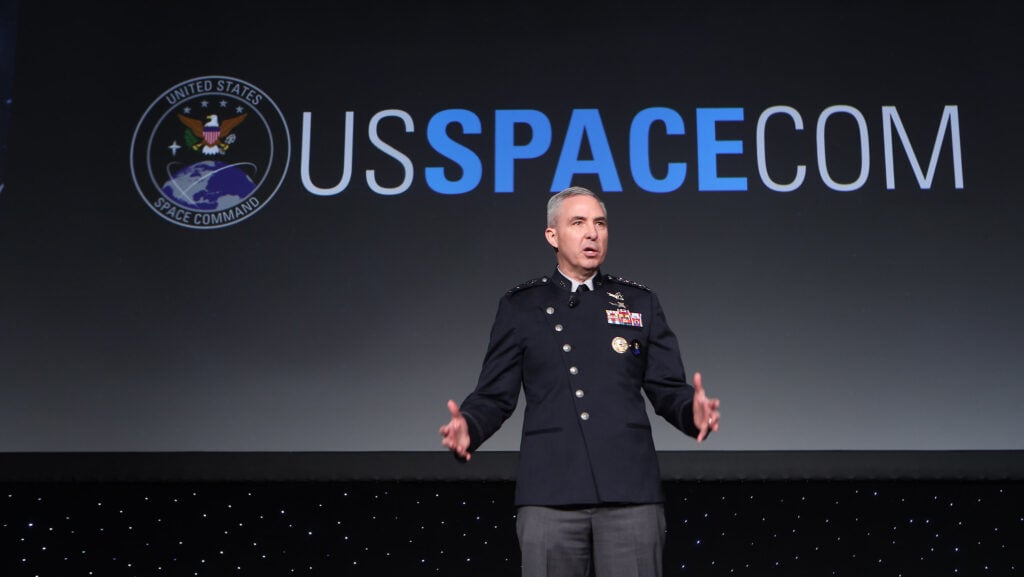US SPACECOM Commander Gen. Stephen Whiting addresses Space Symposium 2024. (Space Foundation via Flickr)
WASHINGTON — As part of its overarching effort to improve command and control capabilities, US Space Command is putting together a pilot project aimed at showing how data can be fused to create a common “picture” for operators to work from, according to the top SPACECOM leader.
“We need improved command and control capabilities to fuse all this data, be able to display it to us. Now, can we operate without having that single, common operational picture, absolutely, but we want to do better,” Gen. Stephen Whiting told the Mitchell Institute today. “I’m not quite ready to announce all the details, but me and my J6 have just decided in the last month or so that we’re going to pick up a test case in one of our mission areas, where we feel like there’s a lot of data and … we’re going to be able to fuse all the data we have and put it on a single pane of glass.”
The J6 is SPACECOM’s Director of the Digital Superiority Richard Yu, who is responsible for command, control, communication, and computer systems.
Whiting explained that the idea is to set up a pilot that can provide results “over a reasonable amount of time” and for “a reasonable cost,” although he is “still waiting to get that POAM [plan of action and milestones] back of what that time will be and what it’s going to cost.”
The exact mission area for the pilot is still up for grabs, he added, saying he expects to make an announcement sometime in the coming “weeks or months.”
SPACECOM’s mission areas include: space domain awareness; space electronic warfare; missile warning; command and control; cyber operations; intelligence, surveillance and reconnaissance; position, navigation and timing; and orbital warfare.
Whiting stressed that SPACECOM won’t be acquiring new capabilities, or satellites, for the pilot — instead working with data and systems already available.
“We’re not an acquisition organization, but we think this is the kind of value a COCOM can add because we can deliver that within our event horizon of now to three years. And it’s about merging data. It’s not about building a new satellite system, but it’s taking the data we have and using it better,” he said.
Space domain awareness is one of the mission areas that Whiting said currently needs improved command and control capabilities.
“We still, in some ways, use a command and control system for our space domain awareness based on technology from the 1980s-1990s, a system called SPADOC,” he said. “We’ve modernized the hardware; it’s all on modern hardware, but the internal software is still pretty old, and so working with the Space Force and their acquisition arms to deliver an improved command and control capability for us in that mission area would be very helpful.”
SPADOC stands for Space Defense Operations Center. It manages data from the US military’s network of radar and telescopes that detect and track objects on orbit to provide space domain awareness to operators.
New software is needed, Whiting explained, so SPACECOM can begin using machine learning and artificial intelligence tools to sort through the growing tsunami of incoming sensor data.
“You know, today it’s still a manually intensive process to see that a potential threat satellite has maneuvered … and that seems to me to be a mission area tailor made for AI/ML,” he said.
In his wide-ranging online conversation with Mitchell Institute leaders, Whiting also provided new details on why SPACECOM is increasingly interested in what it calls “dynamic space operations” to outrun and/or chase down adversary systems — even including maneuvering across orbital planes, maneuvers that currently are simply too costly due to the large amounts of fuel needed.
“Today, when we operate in space … even though everything in space is moving and it’s dynamic, it’s really positional warfare, because we try to go to energy neutral states. And typically that’s because we only have the fuel we’ve launched with, and so we never want to move. Or if we do, we always ask the question, ‘how much life is this going to take off the back end of the satellite?” he said.
Whiting said that in future SPACECOM wants “to get to a place where we can maneuver in the domain, just like we do in every other domain. You can’t imagine talking about a tank or a ship or an airplane without its capability to maneuver across the battlefield.”
Obviously, he said, the goal isn’t to be able to refuel every single satellite on orbit or every type of constellation for all missions. But for high-value satellites that exist in small numbers, such as many of the Defense Department and Intelligence Community satellites now operating in geosynchronous Earth orbit (GEO), that capability would be ideal for facing some on-orbit threats.
“Maybe you’re being targeted by a red capability. And what if that red capability can refuel, but you can’t? Now, it can persistently chase you until you run out of fuel, and that’s not a state you want to be in. You want to be able to continue your mission,” he said.
Further, Whiting said, SPACECOM wants to be able to “operate beyond the traditional orbits,” which include GEO, medium Earth orbit, low Earth orbit and highly elliptical orbit that crosses over the Earth’s two poles.
“If somebody goes in between those orbits, places we don’t typically operate today, we don’t have a great capacity to get there. So we want a maneuvering capability that allows us to maneuver through multiple orbital regimes. We think that will help limit the opportunity for operational surprise,” he said.





















Discussion about this post